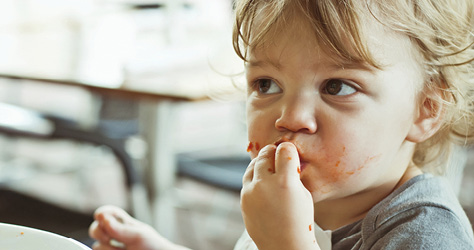Find out what foods your pre-schooler needs to grow, and get advice on five steps you can take to make sure their diet is healthy
Now they’re two, they’re eating the same food as you, and every meal is a balanced one...No? Don’t worry, you’re not alone. Read our guide to the foods your pre-schooler needs – and our five steps to achieving a realistic, healthy diet.
Your pre-schooler’s food needs are quite similar to your own. Here’s what they need:
At a glance
- Keep snacks healthy
- Step back from food wars
- Keep offering new foods

Fruit and vegetables
Contain lots of vitamins, minerals and fibre, so include at every meal. Different fruits and vegetables contain different vitamins and minerals so aim for a wide variety.
Carbohydrates
Starchy foods like bread, rice, pasta, potatoes and couscous provide energy, nutrients and some fibre.
Protein
They need one or two portions of protein a day. That could be meat, fish, eggs, pulses (lentils, hummus, tofu etc). It’s best to avoid whole nuts until they’re five. Aim for two portions of oily fish (such as mackerel, salmon and sardines) a week.
Dairy products
A good source of calcium and vitamin A; try to give three servings a day. Lots of pre-schoolers go off drinking milk, but they can get the recommended 350milligrams a day of calcium from cheese, yoghurt, fromage frais, mashed potato, sauces etc. Once they’re two they can have semi-skimmed milk.
Fat
Young children, especially those under the age of 2, need the energy provided by fat. There are also some vitamins that are only found in fats. This is why foods like whole milk, yoghurt, cheese and oily fish are so important. Once your child is 2, you can gradually introduce lower-fat dairy products and cut down on fat in other foods – provided your child is a good eater and growing well. Keep high-fat processed foods like pizza, oven chips, sausages and crisps for a weekly treat.
Vitamins/minerals
The Government recommends a vitamin A, C and D supplement for all under fives. It’s also important to make sure they get enough iron – which comes from meat and fish, fortified breakfast cereals, dark green veg, lentils and dried apricots/figs. If they’re still drinking a lot of milk instead of eating proper meals, they are at high risk of iron deficiency, which can lead to anaemia. Ask your health visitor or GP if you’re worried.
Five steps to a healthy pre-schooler diet
- Don’t worry if not every meal is a balanced one. A two-year-old’s appetite is a strange and varied thing. Don’t fret if they only eat one good meal in every three or four – they actually have quite a good natural instinct for what they need. To reassure yourself, look at what they’ve eaten across the week or fortnight rather than at every meal.
- Keep snacks healthy (and savoury). If they’re not eating that well at mealtimes then healthy snacks will help keep their diet on track: a few cubes of cheese and a couple of cherry tomatoes have lots of good protein and calcium and count as one of their five a day of fruit and veg. Cucumber fingers dipped in hummus is also far better than biscuits or raisins, which are packed with sugar.
- Step back from food wars. The biggest change from the previous 12 months is that your two-year-old probably wants to assert their independence over their food: it’s not really about the food, it’s about power. Maybe a few months ago they’d eat your lovingly prepared casserole but now they’ve decided they don’t like sauces or stringy meat (two very common areas for rebellion) and want nothing but dry pasta, cheddar cheese and a stick of cucumber.
It’s so easy to get anxious: you find yourself pleading ‘just one more pea for mummy’ and suddenly they’re in control. Basically you have to pretend you’re not at all anxious and you don’t care either way if they eat or not. So if they won’t eat, clear away without saying anything and let them get down. But no yoghurt or snacks five minutes later or your work will be in vain!
- Keep offering new foods. It can be tempting to keep giving them food you know they’ll eat – even if that means peas every day for a month. Keep trying different vegetables, but in tiny portions so they don’t feel overwhelmed. Make no comment if they don’t eat it. You often have to try a new food 15-20 times before it’s accepted, so keep trying and don’t lose heart!
- Big boy/girl cutlery. It’s a good time to teach them how to use cutlery – a skill they’ll need by the time they start school at four. Most three-year-olds have enough dexterity to wield a spoon and fork, and once they’ve mastered it you can add in a small child-friendly knife. It also makes them feel grown-up and part of the family to feed themselves– even their old high chair will be packed away by now so they can join you round the table.
The Healthy Start scheme provides vouchers for pregnant women and families who qualify. You can use these to buy milk and plain fresh and frozen vegetables at local shops, and you also get coupons that can be exchanged for free vitamins.